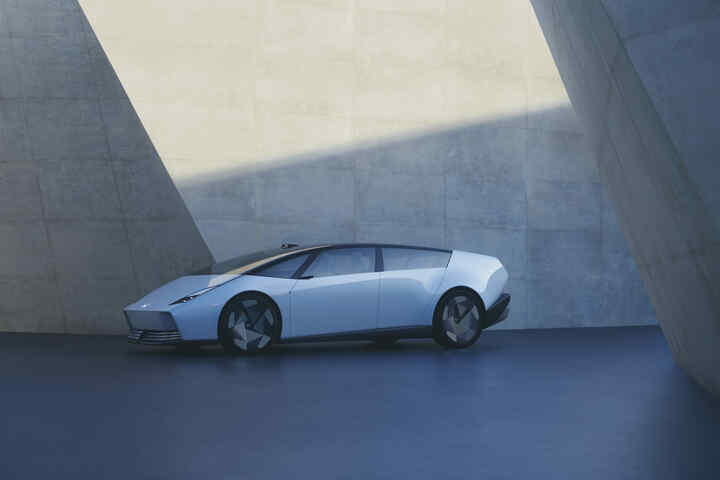The next generations of Honda.
At Honda, we’re changing the concept of mobility. For years we’ve been developing and advancing technologies with our fleet of much-loved hybrid electric vehicles (HEVs) and electric vehicles (EVs). We’ve now entered a new era in mobility, balancing innovation and sustainability to redefine and reimagine the future of transportation. The 0 Series (pronounced ‘zero’) represents Honda’s direction for electrification, offering the joy and freedom of mobility, with minimal environmental impact. And all from a brand you know and trust.
In simple terms, the 0 Series vehicles are EVs of the future that are being designed now. Prepare to be wowed!

Go back to the starting point
Since its inception in 1948, Honda has been inspired by the power of dreams and the premise ‘If you make a superior product, people will buy it’ – Soichiro Honda. Today, this mantra still rings true and the technology we’re developing will make journeys both safer and easier for drivers and passengers alike.
Going back to starting point, or zero, we’ve applied all our engineering expertise gained over 70+ years, and have created the 0 Series Saloon and SUV, based around five core values:
The Five Core Values
1. An artistic design that resonates with people
2. Automated Driving / Advanced Driver Assistance Systems (AD/ADAS) that ensures safety and peace of mind
3. New value of EVs as a ‘space’ for people, made possible by the internet of things (IoT) and connected technologies
4. The joy of driving with the feeling of oneness with the vehicle
5. Outstanding electric efficiency
Thin, Light and Wise
Overturning the conventional idea of EVs being bulky and heavy, the 0 Series has been designed by applying a unique ‘Thin, Light and Wise’ approach. The aerodynamic design of both the Saloon and SUV has been created with a lower vehicle height, thanks to its dedicated ‘thin’ EV platform that creates a lower floor height, revolutionising the look versus traditional EVs. Advanced technologies have resulted in a 100kg weight reduction, producing a ‘light’, sporty drive that combines with efficient electricity performance and fast charging, to deliver a new era in EVs.
Technical know how
The futuristic design is matched by Honda’s technical know how. Twenty-five years ago, Honda led the way with the creation of ASIMO (Advanced Step in Innovative Mobility), a lovable humanoid robot that became an icon in the field of robotics, taking the world by storm. The unique values of ASIMO have been evolved and combined with the advancement of AI, resulting in ASIMO OS, our own operating system which will run the 0 Series.
Peace of mind
Using Honda’s unique ‘human-centric’ safety concept, Automated Driving (AD) will allow ‘eyes-off’ driving in certain situations, where the vehicle will drive itself. Using advanced AI technology developed over years, ASIMO OS will sense the environment around the vehicle, recognising and detecting the conditions with ‘wise’ human-like, high-precision risk predictions. With a comprehensive evaluation and understanding of both the internal and external environments, the vehicle will be able to respond appropriately, taking emergency evasive action if needed, meaning that if an animal jumps out or an object suddenly appears in the road, the vehicle can react accordingly.
Redefining Mobility
Smart technology
Expanding the scope for ‘eyes off’ self-driving will open new possibilities for mobility, freeing the driver’s time for other things. Honda’s AD and Advanced Driver Assistance Systems (ADAS) will prioritise both occupant safety and comfort, using advanced vehicle dynamics technology to ensure smooth, controlled movements when navigating obstacles and changing lanes. Simply getting into the vehicle will unlock an ultra-personalised experience, seamlessly adapting to your preferences by fine-tuning cabin settings such as playing music that matches your mood, learning your habits, adjusting ambient lighting to your vibe, and more.
The technology will even continue to develop and progress after you’ve purchased the vehicle, much like smart phones do with OS updates, with the vehicle becoming increasingly personalised, the more you use it.
Zero environmental impact
Honda is determined to achieve ‘zero environmental impact’ throughout the vehicle’s life cycle, including corporate activities, and ‘zero traffic collision fatalities’ involving Honda motorcycles and automobiles. A bold claim but one that we believe is achievable.
The next generation of EVs
The 0 Series is delivering a new vision for Honda that will bring back the joy of driving and a fresh approach to EV development. Are you ready to drive the future? Keep your eyes peeled for the launch of the 0 Series Saloon and 0 Series SUV, coming Summer 2026.
To find out more visit 0.Honda










